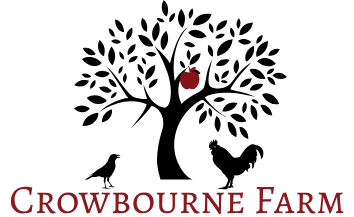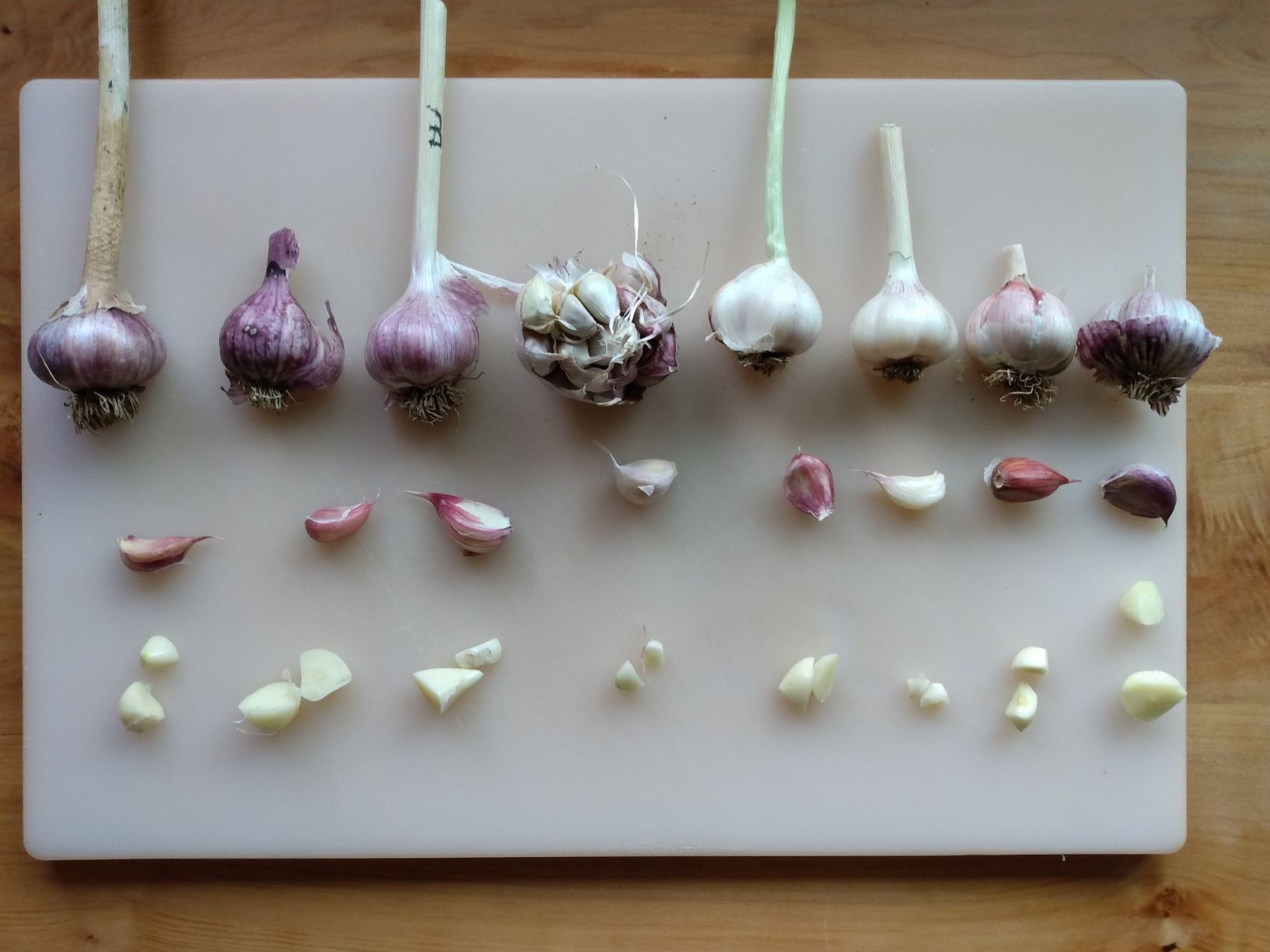

Garlic is one of the world’s most ancient and diverse food plants. With a legacy that goes back to ancient Egypt and Iran, there are hundreds (thousands?) of genetically distinct varieties! Sadly, most of us are only familiar with the basic white garlic sold at grocery stores, or perhaps the Red Russian hardneck that dominates farmers markets and backyard veggie plots.
But there are so many more options, and some unique varieties perfectly adapted to our Island climate.
Types of Garlic
There are 2 broad categories of garlic: Hardneck and Softneck. Hardnecks are easy to grow, particularly in climates with cold winters, and they produce the tasty scapes that can be cut and eaten in the Spring. Softnecks are well-suited to milder winters, do not generally produce scapes, and have the big bonus of storing much longer.
Within each broad category of hardneck and softneck are multiple sub-families, each with their own time to maturity, shapes, wrapper characteristics, and flavour profiles. And within each sub-family there are endless specific varieties to choose from. It can all be quite overwhelming!
Choosing Garlic Varieties to Eat and Grow
Our priority as garlic lovers is to have a year-round supply in our pantry each fall. Some garlics ripen early but don’t store beyond Christmas, while others will store for a full year in the right conditions. So we encourage every household to keep at least 3 varieties: an early, a main-season, and a long-storing type. Within each of these, you have choices along the spectrum of spicy to mild, fewer big cloves or more medium cloves, and a range of beautiful colours.
Crowbourne Farm Varieties
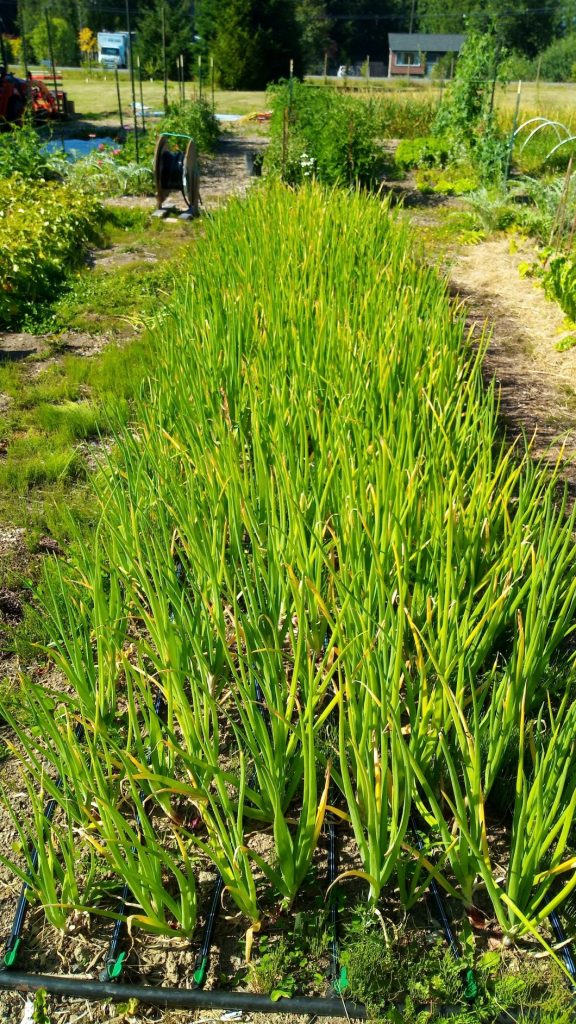
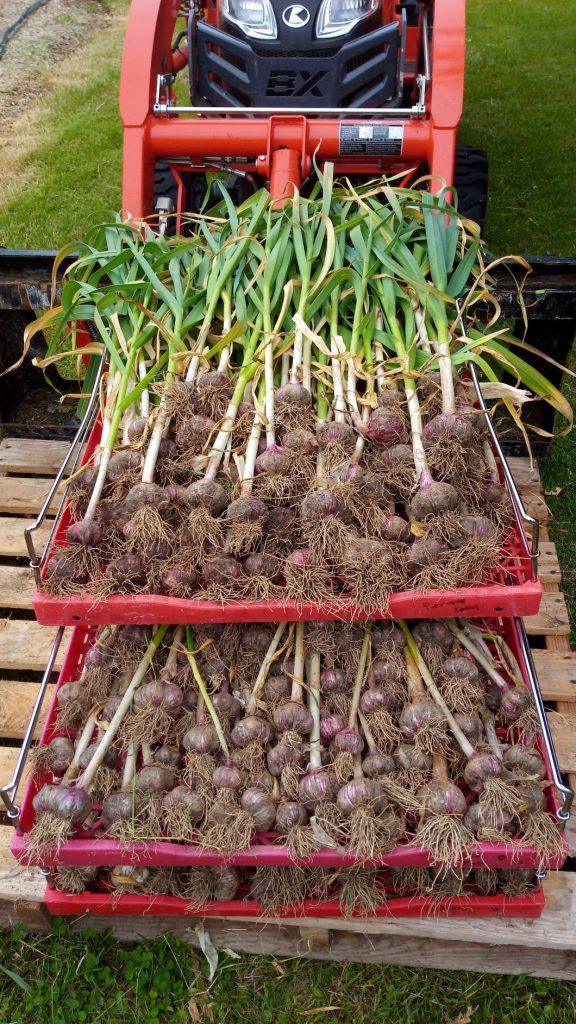
We grow 12-16 varieties each year on our Cowichan Valley farm. Some of these will be experiments, some we will be growing out to build up size and supply, some we will grow for seed. This means not all varieties will be for sale every year. Watch for updates in August of each year to find out what’s available.
2023 Garlic List
Early Varieties
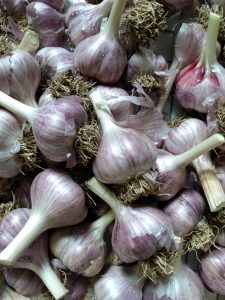
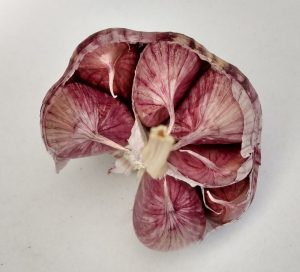
These are generally Asiatic and Turban species. They are ready for harvest in early June and the Asiatics can be nice and spicy!
China Rose: A beautiful dark purple garlic, China Rose has evenly formed, good sized cloves in each bulb. It has good heat, perfect for stir-fries and other quick-cooking dishes. China Rose is a very early Turban species that should be enjoyed throughout the summer and fall; it won’t store long into winter.
Wildfire: Wildfire brings the heat! This is a garlic that can match the wasabi in your kitchen. It is an early Asiatic variety with uniquely shaped scapes that don’t need to be cut. Wildfire tends to produce large bulbils on the stem and scape, but these don’t seem to affect the bulb size. A medium to large head with 4-6 cloves per bulb. Wildfire needs to be eaten through the summer and fall; it will start to dry out by late November.
Main Season
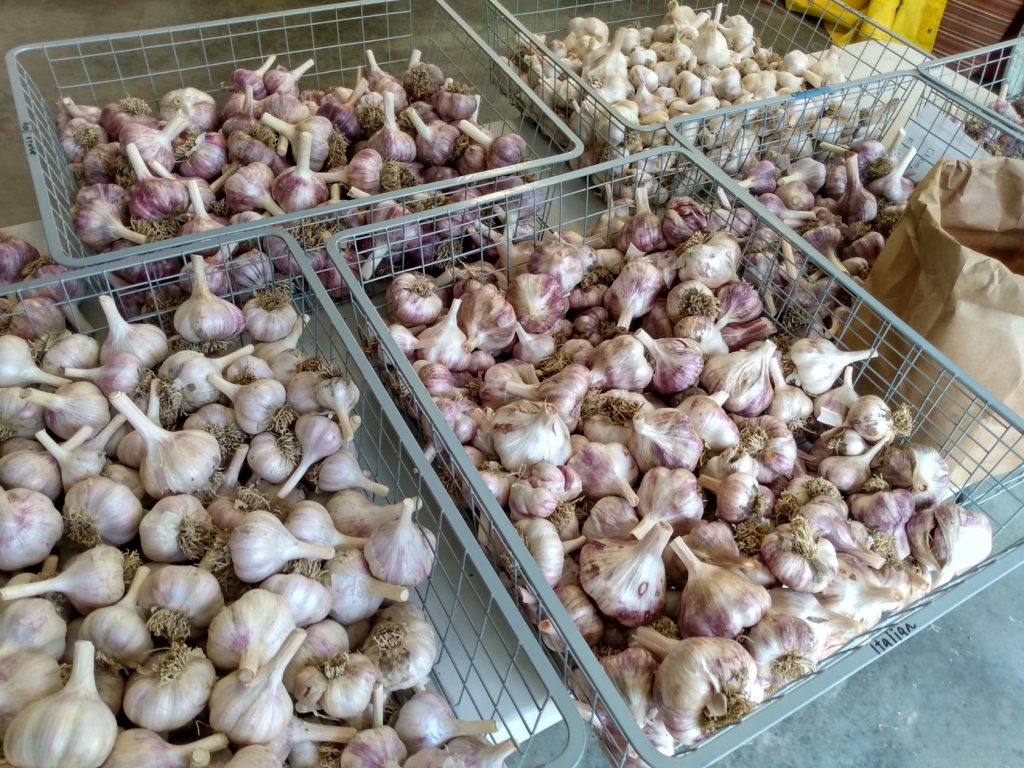
German Red: German Red has been our winner in the Rocambole family. Rocamboles have amazing rich, complex flavours, and are prized by chefs. German Red has very little bite, which makes it perfect for raw use, but the rich flavours stand up to long cooking. Only stores until Christmas, but so delicious while it lasts!
Marbled Purple Stipe and Porcelain garlics are large bulbs with big cloves, and a fabulous flavour. They are perfect for roasting or for any dishes that require LOTS of garlic. These varieties should keep until early spring.
Rod Stone: Rod Stone is very special local garlic variety. It is a huge Marbled Purple Stripe with beautiful shiny purple wrappers. Developed by a Saltspring Farmer and named for his late husband, Rod Stone is perfectly adapted to our Island rain-shadow climate and heavy soils. 6-7 large cloves in each bulb have a wonderfully nutty flavour with just enough heat. Should store well into March.
Creme de la Rasa: A variety developed by Rasa Creek Garlic Farm in the BC interior, Creme de la Rasa is a beautifully flavoured, large Marbled Purple Stripe. Rasa Creek tells us that this variety was a mutation from a Rocambole garlic. Rocamboles have prized flavours, but don’t store well at all, so Creme de la Rasa should have the best of both flavour and life. We have grown this variety from bulbils and in this 3rd year it has produced large to extra-large heads! We have been impressed with this variety’s performance in our variable weather.
Georgian Fire: A Porcelain variety with a rich and powerful flavour, with good pungency. Roasting brings out the complexity and depth. Porcelains have 4-6 large cloves per head, lovely white wrappers and good storage into Spring.
Yugoslavian: This strain of Porcelain garlic has been grown in BC for decades because of it’s wonderful flavour, and it has grown reasonably well here in the Cowichan Valley for us. With a fiery heat that mellows out on the tongue, the 4-6 large cloves are perfect for baking and should store 8-9 months, or into late spring.
Dirom’s Porcelain: Local farmer Jordan Dirom has been growing his family’s Russian porcelain garlic on the Island for ages. This is a well-adapted variety with big white heads, 6-7 large cloves per head, and great–not TOO hot–flavour for cooking. Should store into April.
Northern Quebec: Another really large Porcelain, Northern Quebec has a very distinctive flavour! Less heat than other porcelains, try this one for roasting or even for raw dishes that need a lot of garlic with less bite. Loves a cool winter and spring.
Long Storing
Creole Varieties
Rose de Lautrec: Rose de Lautrec might be our favorite garlic on the homestead. A renown French Creole type, it has stunning fushia-coloured inner wrappers around 8-10 cloves per bulb. The flavour is totally unique, with mild heat and lots of complexity; it complements raw Mediterranean marinades and salads beautifully. Best of all, it stores like a dream–we’ve often got perfect bulbs left from the year before, even as we’re harvesting new bulbs in the summer garden! We’ve grown this variety out over the years to produce nice, large heads, and now we’re trying to the same with other Creole varieties.
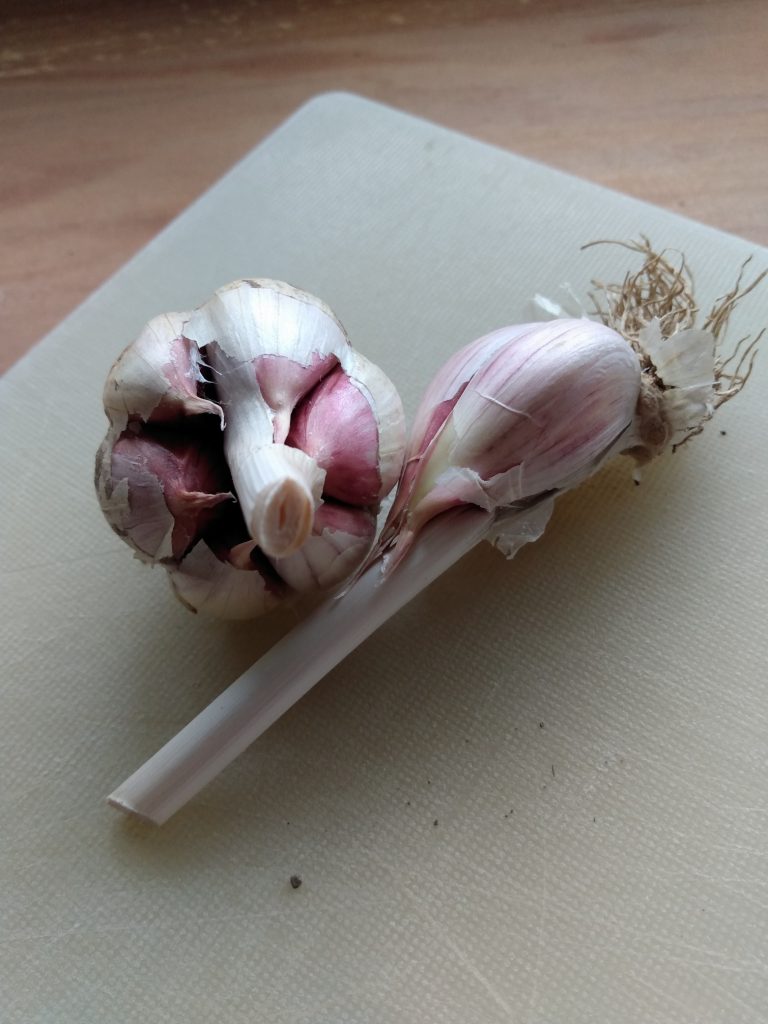
Softneck Garlic
Softnecks and their cousins, the so-called Weakly Bolting Hardnecks will store the full year-round, and in some cases even longer in the right conditions! We are working on growing out a selection of our favorites: the Creoles (a family of weakly bolting hardnecks). Creole garlics hail from northern Spain and Portugal and Southern France, whose climates are very similar to the Cowichan Valley. These garlics have unique and complex flavours, stunning colours, and successfully store a full 12 months for us. They are hard to find as growers in other parts of the country struggle to get them to do well, but we’re convinced they are the perfect garlics for our Island region!
We have also been impressed with the softneck varieties we grow, and we’re expanding our list this year. There are 2 main types within the softneck family: Artichokes and Silverskins. Artichokes grow into large, lumpy bulbs with a huge number of cloves–as many as 16 to a head! Silverskins are similar, but less lumpy, and with the longest reputed storage life–some farmers report being able to keep them 18 months to plant a full year after harvest! Our varieties of softneck garlics have a centuries-old history of being grown in our region.
NOTE: No Softnecks are available in 2023
Italian: This Artichoke variety was a real favorite of ours in 2019. It grew HUGE heads, stored well into late Spring (May), had a dozen or more large cloves per head, and looked beautiful with it’s shiny pearl-like wrappers. Mild in heat, this was our favorite variety for roasting, but was equally good in salad dressings or other raw dishes where you may not want too much kick.
Formidable: Another popular Artichoke variety, Formidable has lovely white wrappers streaked with just a little bit of pink. A well-rounded flavour works in all dishes, and the bulbs should store well into late Spring. A new variety for us this year.
Inchelium Red: I have high hopes for Inchelium Red this year! Another artichoke variety, Inchelium Red was being grown by the Colville First Peoples before the first settlers arrived. The traditional territory of these confederated tribes stretches along the Columbia River basin, covering much of Eastern Washington State, into north-eastern Oregon, and much of what we know as the Okanagan and Kootenay valleys in BC today. Inchelium Red is likely the oldest variety in North America. What a legacy to be preserving here!
Nootka Rose: Nootka Rose is an heirloom variety from the San Juan islands, just to the south of us. One of the most beautiful garlics we grow, it is a pure white bulb with bright pink clove wrappers. Nootka Rose is a Silverskin with lots of heat, and should store well for a year (or even longer?). The bulbs can get large, and are lumpy with a 12-16 cloves to a head.
